|
|
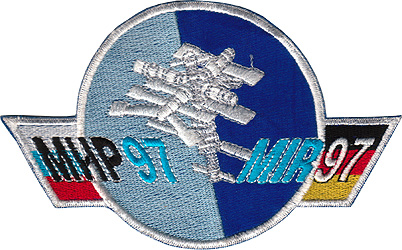
| Crew & Mission |
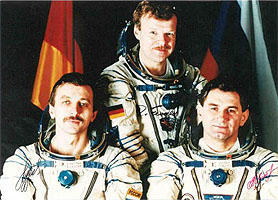
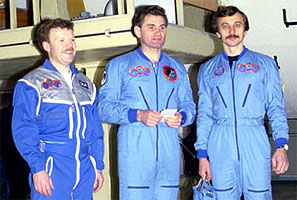
Left: The crew in their training Sokols. Right: The crew in their training IVA-suits
Mission
| The Flight Sokols |
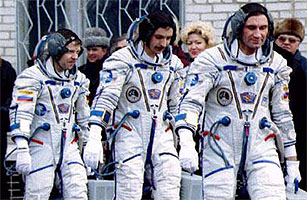
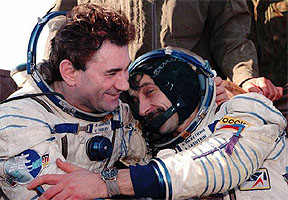
Left: The Soyuz TM-25 crew in their flight sokols. They were the first to wear the yellow-tab Rossia flag. Right: Tsibliev and Lazutkin after landing.
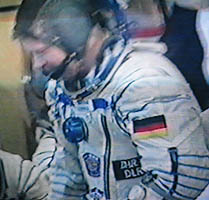
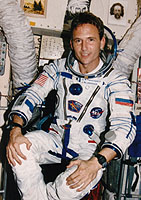
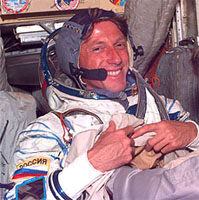
Left: Ewald's DLR and German flag patches. Center: Jerry Linenger in his flight Sokol aboard Mir. Right: Michael Foale wearing his Sokol aboard Mir. Note the new layout of the flags, which is similar to Ewald's suit.
.
| IVA Wear |
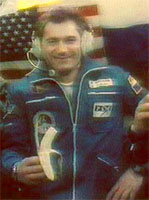
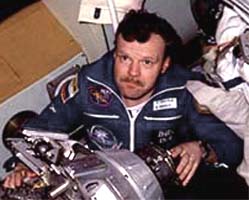
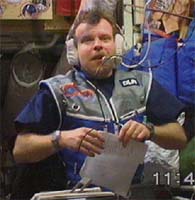
Left: Tsibliev wearing his PK-14 suit on arrival at Mir. Center: Ewald wearing his PK-14 suit. Right: Ewald in his daily working cloths.
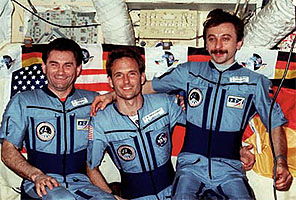

Left: Tsibliev, Lazutkin and Linenger in their Penguin suits. Note that they have cut-off their sleeves. Right: Foale in his Penguin suit.
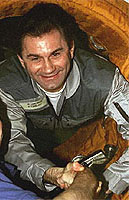
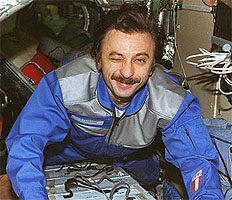
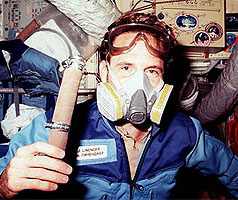
Left: Tsibliev wearing his "modern" Mir-suit. Center: Lazutkin wearing his "modern" Mir-suit. Right: Linenger wearing his "modern" Mir-suit.
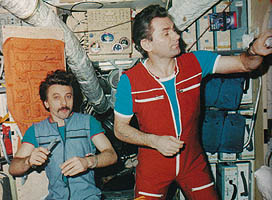
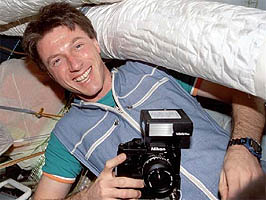
Left: Tsibliev and Lazutkin in their daily "working" cloths. Right: Foale in his "working" cloths.
| The Orlan EVA-suits |
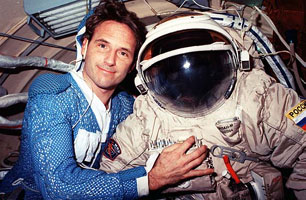
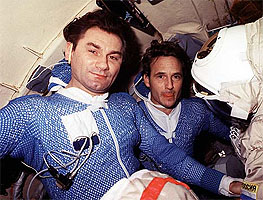
EVA text
| EO-23 / TM-25 Crew Patches |
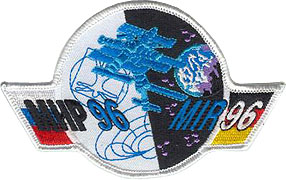
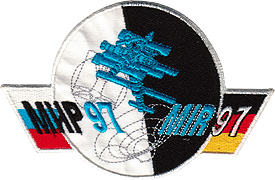
Left: The Mir-96 design, embroidered by Stewart Aviation. Right: An early version of the Mir-97 emblem.
Like other international missions, the Mir-97 logo was adopted as the official mission patch and worn on the flight Sokols during launch and landing. Innitially, the mission was planned for 1996, so the German program was called Mir-96. We have only seen the design of the Mir-96 logo as a Stewart Aviation souvenir patch, which was derrived from a printed version. This version, which included a Leonardo Da Vinci symbol, a scientific drawing and the Earth, was made into a Mir-97 logo by simply changing the 96 for a 97. This version was made available in embroidered form as well, excluding the Earth to make the patch look less crowded. Although this design was aboard on a series of flags, it was not the version that was flown on the Sokol and IVA suits. The black and white background was replaced by two shades of blue and the Leonardo Da Vinci and scientific symbol were left out.
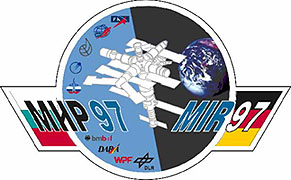
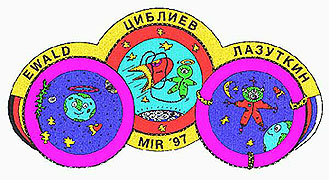
Left: The Mir-97 artwork. Right: The Soyuz TM-25 artwork by artist Andorea.
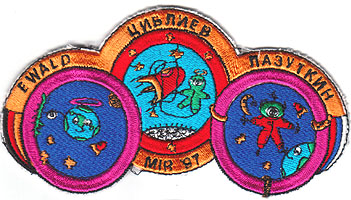
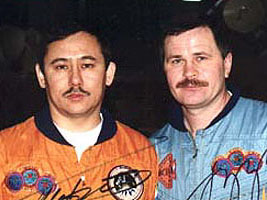
Left: The embroidered Soyuz TM-25 crew patch. Right: The backup crew of Talgat Musabayev and Nokolai Budarin wearing the patch.
This mission not only had a "scientific" mission logo, but also a Soyuz crew patch. This probably was an innitiative of DLR, along the same lines as the patch for Klaus Detrich Flade's Soyuz TM-14 mission. Like the TM-14 crew patch, it was available in both a primary (Tsibliev, Lazutkin, Ewald) and a backup variant (Musabayev, Budarin, Schlegel). It was designed by an artist named Andorea and consisted of three colorful circles, with children's drawings. It was the first TM-25 / EO-23 patches that was spotted - both the primary and backup crew were wearing it during training.
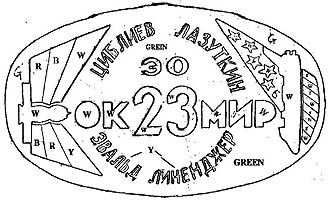
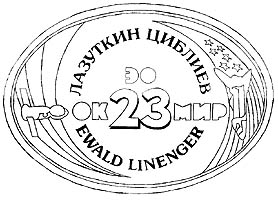
Left: The design made by Oleg Shitikov. Right: The artwork finalized by Luc van den Abeelen.
Then, of course, Novosti Kosmonavtiki also designed a patch for the entire EO-23 mission, which would also include US astronaut Jerry Linnenger. This patch, like the EO-20 and E0-21 patches, was designed by Oleg Shitikov. It had an oval form and a green background. It was faxed to Spaceview in Amsterdam and embroidered by Aviation Patch Supplies. When Jaap Terweij and Luc van den Abeelen of Spaceview received the patches, they immediately noticed something was wrong: the yellow of the German flag was embroidered in white. As a result, a second batch had to be made and the distribution of the patch was delayed. The second batch used a darker color yellow, which - unfortunatley - makes it hard to make out the names of the cosmonauts against the green background.
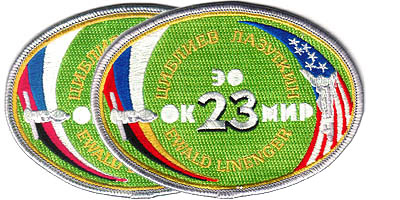

Left: The two versions of the Aviation Patch Supplies patch. Right: Lazutkin showing the patch.
When the crew of Soyuz TM-25 faced the press a few days before their mission, Tsibliev and Lazutkin could be seen wearing another EO-23 patch, bearing the flags of the participating countries in this mission, but only their names. It was designed by a new group of Russian spaceflight enthusiasts: Planeta Zemlja. Unlike the Videokosmos/Novosti Kosmonavtiki group, they had succeeded in reaching an agreement with all the parties involved. Secret of their succes was the involvement of RKA Energia cosmonaut Feodor Yurchikin, himself an avid patch collector. Although the Planeta Zemlja patch became the official version, the Novosti Kosmonavtiki/Spaceview patch was much more known to collectors at the time because of Stewart Aviation's involvement. The Planeta Zemlja version was designed by Dmitriy "Dima" Shcherbinin and probably embroidered by the Vimpel company. It uses a black felt background instead of twill.
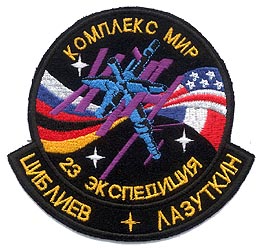
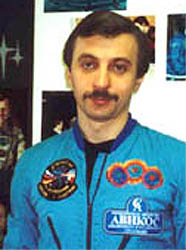
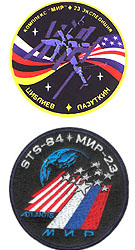
Left: The Planeta Zemlja EO-23 patch. Center: Lazutkin wearing the Planeta Zemlja patch and the Andorea crew patch during the press conference before launch. Also note the Avikos insurance company patch. Right: The artwork (top) without the French flag and the Planeta Zemlja STS-84 patch (bottom).
Planet Zemlja als designed a patch for the STS-84/Atlantis mission to Mir, but this emblem - also embroidered onto black felt, probably by Vimpel - was purely commemorative and is the least known of the five EO-23 patches available.
| Personal Patches |
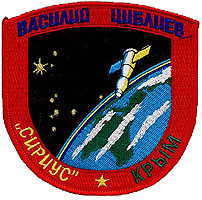
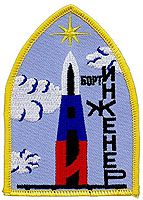
Left: Tsibliev's Molchanov patch; he did wear it. Right: Lazutkin's Molchanov patch. We've never seen him wearing it.
| Availability |
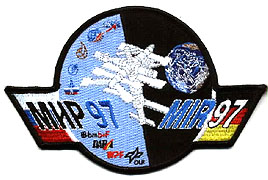
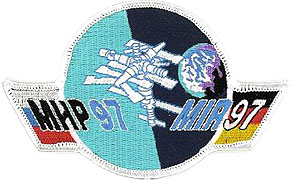
Left: Eagle One Aerospace Mir-97 patch. Right: Stewart Aviation Mir-97 patch.
At this time, Stewart Aviation in England had already decided to co-operate with Spaceview, so unlike earlier Novosti Kosmonavtiki-patches, only one version (not counting the version with the white German flag!) of the green Mir-23 exists. The Andorea patch and the Mir-97 were copied by both Stewart and Eagle One Aerospace, though.